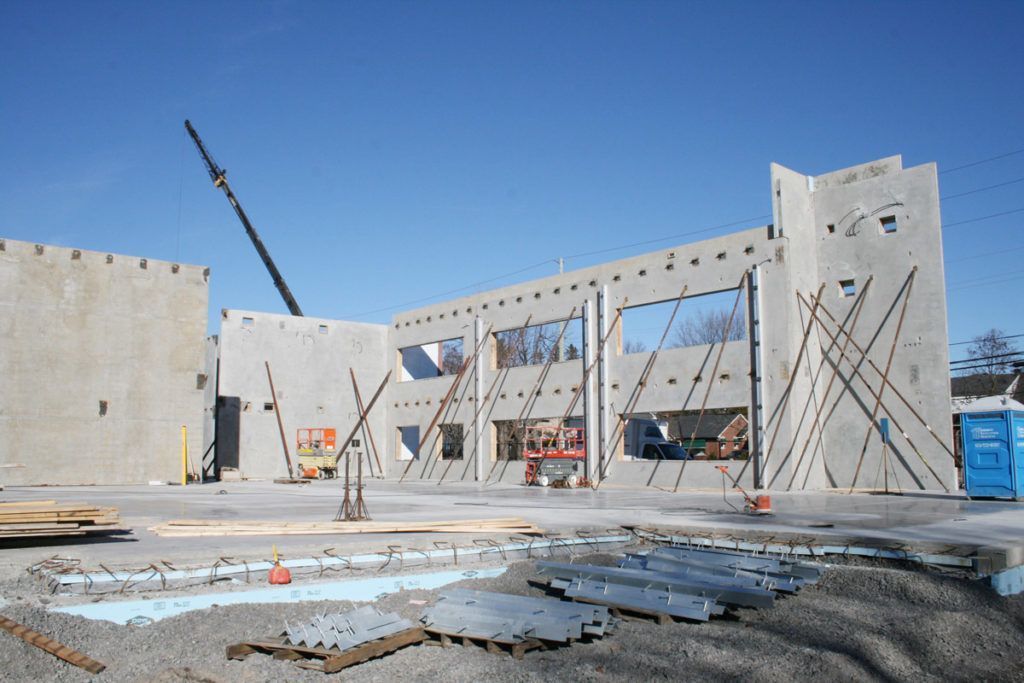Thermal Performance of Concrete Tilt-Up Panels

“What’s the R-value of a Tilt-Up concrete wall?”
The simple answer to the question is solid, Tilt-Up concrete panels have very little R-value (0.08per inch). In fact, concrete allows energy to flow through it roughly 60x faster than insulation. However, insulation can be added easily to any Tilt-Up panel.
Insulating Concrete Panels
Systems are available to add insulation products on the outside, the inside or within the wall referred to as a sandwich panel. The insulating materials used for these systems range in R-value. By placing 2-inches of extruded polystyrene within a Tilt-Up panel as a “sandwich” panel, the material R-value of that wall is increased to 11.49 with air-film coefficients of 0.85.
While this data answers the basic question – the actual performance rating of Tilt-Up panels is the more difficult concept to understand as it combines two additional physical characteristics of materials: thermal conductivity and thermal mass.
Insulation is a key component for buildings that attempt to closely control interior temperatures and/or humidity. Thermal conductivity is the flow of energy through materials. Most of us are aware that a wood-framed wall is essentially 30 percent or more un-insulated due to the amount of solid stud area displacing the fiberglass batts. The same concept exists for insulation systems in concrete panels.
Eliminating Thermal Bridges with Tilt-Up Panels
Historical examples of insulating concrete have included structural steel sandwich panel connections, solid regions of concrete and steel furring members that separate, displace or penetrate insulation pieces or compress the insulation to ineffective regions. These areas of steel, concrete and ineffective insulation allowing more rapid zones thermal conductivity are known as thermal bridges. Today, insulation systems specifically designed for Tilt-Up construction provide the effective solution by eliminating the occurrence of these thermal bridges and providing the full material R-value of the insulation.
Surface-applied insulation options garner material R-values between 5 and 15, while sandwich panels with as much as ten-inches of insulation boost material R values as high as 50. Sandwich systems available today vary in both thermal performance and structural capacity. Designers for projects wishing to incorporate sandwich panel technology into their Tilt-Up projects should evaluate system options based on their own unique conditions.
Thermal mass “performance” of the exterior concrete walls can be the key element of success for Tilt-Up as an efficient insulating option. Concrete that is located adjacent to controlled interior spaces and insulated from the climate changes of the exterior dampens the temperature swing that is normally experienced as daily temperatures rise and fall. This dampening effect often results in substantial energy savings and savings from reduced HVAC sizing. Essentially, the mechanical systems don’t have to work as hard to control the temperature. The same quantity of energy may need to be removed or added, but it is done so over a longer period of time.
Energy-Efficiency of Tilt-Up Systems
The combination of the thermal mass properties of concrete, higher energy-efficiency insulation systems and reduced air-infiltration allow Tilt-Up to be an optimum energy-efficient solution in addition to a growing architectural solution. The large, solid concrete panels also add to the energy efficiency of a Tilt-Up structure since the panel size reduces infiltration or air leakage into and out of the building. Air infiltration is a large source of heat loss.
“Jim Baty, Technical Director of the Tilt-Up Concrete Association”
